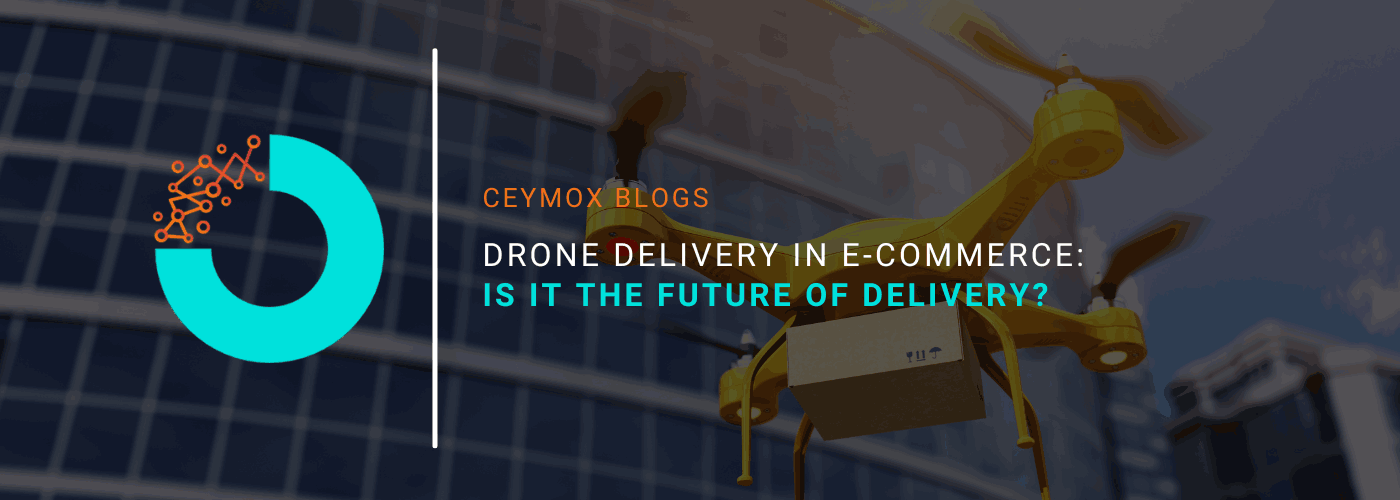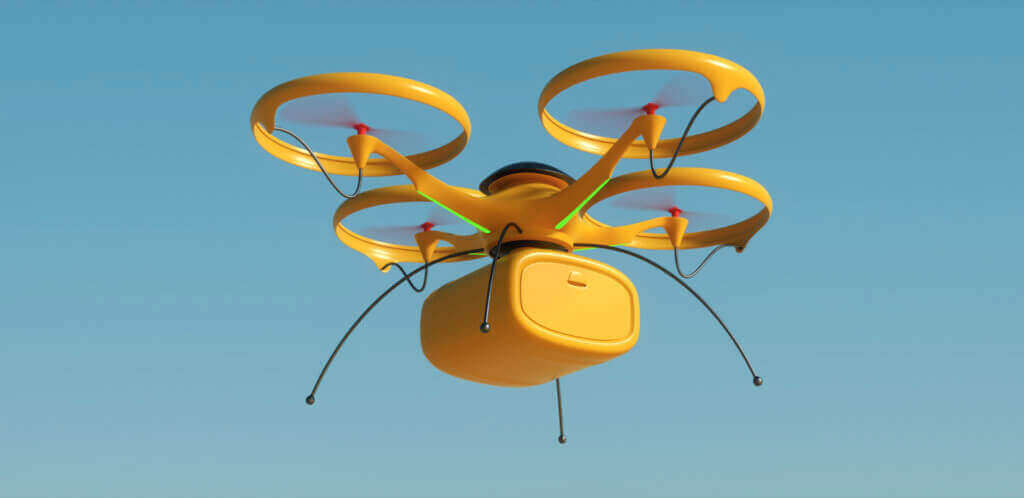
The drone delivery market is expected to grow at a CAGR of 49% from 2022 to 2030 and can reach a valuation of $5,556 million in 2030 from $228 million in 2022. We are witnessing revolutionary changes in the logistics industry. Due to the recent global COVID-19 pandemic, many countries have realized the potential of drone technologies in the logistics market. From the start of the pandemic, the online shopping market flourished at a huge pace. Today, people can order groceries, collectables, and even prescribed medications at their doorstep. But with the increase in delivery count, certain issues such as theft, public safety, and environmental harm, are emerging. The customers also want quick deliveries in the minimum possible time. Thus, online retailers are considering creative methods to reduce delivery times to maximize their revenues and conversion rates. Drone delivery is one such solution that is in exploration to meet these customer expectations. Drones are slowly becoming the best alternatives to traditional shipping to transport goods from the warehouse to a customer’s doorstep. These advanced flying machines are redefining the deliveries as well as customer experience for any online purchase. In this article, we will go through the different aspects of drone delivery and how it can impact delivery in the e-commerce industry.
What are Drones?

Unmanned Aerial Vehicles (UAVs), Commonly known as Drones is simply flying robot that is remotely controlled or fly on their own using flight plans controlled by software, onboard sensors and a global positioning system.
Initially, there were only used for military purposes. They were employed as platforms for weaponry, anti-aircraft target practice; and information collection. But now they are open for common public use as well but with certain regulations. Now they are used for search, and rescue surveillance, firefighting, traffic monitoring, weather tracking, photography & videography, agriculture, as well as in delivery.
How do Drone Deliveries work?
In the drone delivery process, when the customers made a successful order, the item is packed at a nearby warehouse and dispatched via special packaging. Then, it is attached to a drone that takes off from the warehouse. A customer has already shared the GPS location of his address that the drone uses to navigate by GPS. On reaching the final drop-off location, in-built cameras and sonar tech help in avoiding any collision during the flight.
At the final delivery, the drone may lower the item to a safe location marked by a QR code. The drone will scan this code to verify the delivery. There is a specially marked mat that the customers should possess to identify the drop-off point correctly. The drone will identify this mat and lower it down for delivery. After the successful delivery, the drone will return to the warehouse for another order.
Drones in E-commerce:
The e-commerce industry can reach new heights by employing drones for delivery purposes. Drone delivery will not just save time but also the cost for reaching the last mile and the urgent expedited delivery demands of the customers. Same–day delivery is become a major demand in multiple e-commerce industries, and this miracle can be achieved only by drone delivery. The drones also consume very less energy per kilometre than traditional delivery methods. They are cheaper and unlike delivery trucks or vans, they can quickly reach the remotest places. Thus, the sellers are considering drones to shorten delivery items and increase revenue and conversion rates.
Does fast delivery matter?
Today, once mind-blowing two-day delivery has become the new five-day. As per a report of Mckinsey, nearly 90% of the customers find the two-day delivery as a minimum baseline to offer by brands, while the same-delivery is what people expect in near future. The important thing is that the brands that can’t meet these expectations will suffer 46% shopping cart abandonment at the checkout stage. That’s why more than 75% of online sellers give utmost priority to two-day delivery. 40% of these also trying to deliver same-day by this year.
Usabilla also performed interesting research and found in its study that the major reason for abandoning carts is high shipping rates. While another 8% of the buyers don’t complete the purchase because of the longer-than-expected delivery time.
Now it is clearly evident that in delivery both time and cost can affect the conversion rates. If an online store can’t meet these expectations, sales will definitely be going to fall. It arise questions that are these expectations realistic and what new delivery methods may cover such demand.
Benefits of Drone-delivery in E-commerce:
1. Improves Customer Experience:
Drone delivery will be highly fast and hassle-free for the customers. The aerial distance is always less than the distance by land. Also, there are no issues of traffic or narrow ways in the air. UAVs use a shorter and more direct route which saves time. Because there are no restrictions on standard rapid logistics shipping routes, the flying speed is also quite fast.
2. Lower Costs:
The first or initial cost of the drones is considerable, however, the running or upkeep cost of drones for delivery is far less expensive than traditional manual delivery. While labour costs will rise in the future, drones have essentially no costs other than charging and maintenance. Nearly 40% of the cost of delivering is spent at the last stage of delivery.
3. Easy access to remote areas:
Drones delivery will give maximum benefits to rural or difficult-to-reach areas. It can be extremely useful for critical supplies like medicine and life-saving equipment. Whether these are tough terrains like hills, mountains, rainforests, or lack of road facilities, drones will make it simpler to get through these areas.
4. Reduces carbon footprint:
In the existing logistics system, the transportation of goods from the warehouse to the consumers requires a lot of fuel which causes an increase in pollution, traffic, and unnecessary hassle. Even logistics firms want to cut their carbon footprint, and drone delivery could be the best way. Drones use only electrical energy which doesn’t release any greenhouse gas.
Challenges lies in Drone Delivery:
Despite so many advantages, there are several challenges associated with drone delivery.
1. Safe deliveries:
For hundreds of years, humans have been delivering packages and despite so much experience, there are still occurrences of errors. Drone deliveries are also prone to issues such as unsafe landing areas. The drones can’t open mailboxes, porches can be covered, backyards may have dogs, etc. Some companies have proposed a method of parachute delivery but it isn’t reliable and depends on weather conditions. Popular logistics company DHL has suggested having a secure “smart locker” and once the delivery is made the recipient is sent a special code to unlock it.
2. Security:
Even if the landing issue gets resolved, the security issue would be another major concern. Since the drones will be travelling autonomously, the computer system should be impervious enough to not only prevent theft but also shouldn’t be hacked. A hacked drone poses a threat to the property, people and aircraft.
3. Regulations:
Now the question arises for airspace. The urban skies are already congested with commercial aeroplanes and helicopters, and there might be not enough space for hundreds or even thousands of drones. Logistics companies need permission to fly drones in the airspace.
4. High first cost:
In the long run, drone deliveries are going to be very financially valuable but it requires a high initial outlay. Currently, the cost of drones along with their software and personnel for their service is really high. Thus, small businesses can be left behind, increasing inequality in the market in favour of large businesses.
5. Limited distance cover:
Commercial drones run on lithium polymer batteries which are not capable of providing power to fly drones over long distances and back. Thus, for multiple or long-distance deliveries, a significant improvement in battery life is required.
6. Limited weight handling:
Currently, Amazon Prime Air drones are able to carry just 5 pounds and Manna supports 4.4 pounds. Thus, drone delivery is capable of only carrying smaller packages.
Major E-commerce Industries That Can Benefited Most from Drone Deliveries:
1. Online Retail Industry:
If the drone comes into the picture, many online sellers will start fulfilling one-day delivery. The time saved will be enormous because the route will avoid traffic and the drones will fly straight. Furthermore, instead of delivering multiple packages before arriving at your location, each drone will have only one mission.
2. Food Delivery by Drone:
The drone delivery benefits are not just limited to the retail industry but also to food delivery. The online food delivery industry is booming but the employees are overworked and struggling. The coronavirus acted as a catalyst to propel its growth. When people were isolated at home, food delivery was the online option to meet their cravings.
Delivery on the roofs of apartment buildings in specifically defined zones could be an excellent alternative to traditional courier shipping. It could also be the creative component that distinguishes one company from another.
3. Medication and the Supplement Industry:
Long-range fixed-wing drones are being used for delivering HIV medicine in African countries quite successfully. It was also successful in controlling the COVID-19 virus in certain countries.
Medicines delivery is probably the only industry that has the most urgent demands. Thus, drone delivery could be highly beneficial for the delivery of medicines.
4. Clothing and Fast Fashion:
The online apparel and clothing industry has been fueled by a sudden growth in the last decade. In 2020, online fashion sales accounted for 46% of total apparel sales. But there is a huge portion of buyers who don’t prefer to buy by judging online pictures or measurements alone. You can’t determine whether the pair of jeans will perfectly fit you by just seeing the picture. Fast drone delivery would allow you to try the item and even return it for a different size the same day… or perhaps several times a day.
Wrapping Up:
Drone deliveries are an adjacent future which may become a mediocre way of delivery in a few years. E-commerce is evolving in every aspect from UX & payments to delivery. At Ceymox Technologies, the best e-commerce development company in India, we develop next-level e-commerce stores meeting your requirements.
 Hubspot SEO Certified |  Hubspot SEO II Certified |  Google Ads Search Certified |  Google Analytics Certified |
Sreehari N Kartha is a skilled Digital Marketing Analyst at Ceymox, certified in SEO. His expertise encompasses a wide range of digital marketing strategies, including managing advertising campaigns on platforms like Google Ads, Facebook Ads, Instagram Ads, WhatsApp Ads, and LinkedIn Ads. With a strong foundation in SEO and SMM, Sreehari is adept at optimizing online visibility, driving engagement, and generating qualified leads and conversions. His passion for emerging technologies, such as Crypto, NFTs, and Web3, further complements his skillset, enabling him to navigate the dynamic digital landscape.
View All Articles